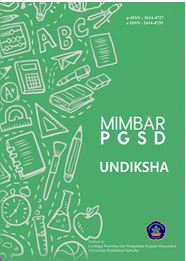Pengaruh Model Pembelajaran CORE (Connecting Organizing Reflecting Extending) Berbasis Koneksi Matematis Terhadap Hasil Belajar Matematika Siswa Kelas IV Sekolah Dasar
DOI:
https://doi.org/10.23887/jjpgsd.v2i1.1992Abstract
Penelitian ini bertujuan untuk mengetahui perbedaan hasil belajar matematika antara siswa yang belajar dengan model pembelajaran CORE berbasis koneksi matematis dan siswa yang belajar dengan model pembelajaran konvenional. Penelitian ini merupakan penelitian eksperimen semu dengan rancangan post test only with non equivalent control group design. Populasi dalam penelitian ini adalah seluruh kelas IV SD Gugus III Kecamtan Buleleng, Kabupaten Buleleng yang berjumlah 127 orang. Sampel penelitian ditentukan dengan tehnik random sampling. Pengumpulan data dengan menggunakan tes hasil belajar dengan soal pilihan ganda yang berjumlah 25 butir. Data dianalisis menggunakan statistik deskriptif dan uji-t independent. Hasil penelitian menunjukkan bahwa terdapat perbedaan hasil belajar matematika antara kelas yang belajar dengan model pembelajaran CORE berbasis koneksi matematis dan model pembelajaran konvensional (thitung = 2,007; ttabel = 1,680). Rata-rata hasil belajar matematika dengan model pembelajaran CORE berbasis koneksi matematis adalah 78 yang berada pada kategori sangat tinggi. Sedangkan kelas yang belajar dengan model pembelajaran konvensional adalah 67 yang berada pada kategori sedang. Jadi, model pembelajaran CORE berbasis koneksi matematis berpengaruh terhadap hasil belajar siswa dalam pembelajaran matematika.Kata Kunci : CORE, Koneksi Matematis, Hasil Belajar
The purpose of this research is to recognize the difference results between Mathematics student who had learnt using the learning CORE march Connection Mathematical and the student who learnt using the conventional learning model. This research is a quasi-experimental research with post test design only with non equivalent control group design. The population on this research are all class of Elementary School Gugus III Kecamatan Buleleng Kabupaten Buleleng which amount 127 peoples. The sample of this research is determined by random sampling technique. In collecting the data the written test were given through a multiple choices tests comprising of 25 items. The Data were analyses using a descriptive statistic and independent test. The result of this research shows that there is the difference result between the student using learning CORE march Connection Mathematical model occurs on Mathematics students with the students using conventional learning (counted 2.007; table 1.680). Average score of the students learnt with CORE march Connection Mathematical learning is 78, it is considered to be high category. Whereas, 67 occurs on the students learning with conventional model, it is considered to be intermediate category. In this research CORE march Connection Mathematical learning model is preponderant for the results of the students in learning Mathematics.
keyword : CORE, Connection Mathematical, learning results.
Published
2014-01-07
How to Cite
., I. N. J. W., ., D. N. W., & ., I. G. M. S. M. (2014). Pengaruh Model Pembelajaran CORE (Connecting Organizing Reflecting Extending) Berbasis Koneksi Matematis Terhadap Hasil Belajar Matematika Siswa Kelas IV Sekolah Dasar. MIMBAR PGSD Undiksha, 2(1). https://doi.org/10.23887/jjpgsd.v2i1.1992
Issue
Section
Articles
License
Authors who publish with the Mimbar PGSD Undiksha agree to the following terms:
- Authors retain copyright and grant the journal the right of first publication with the work simultaneously licensed under a Creative Commons Attribution License (CC BY-SA 4.0) that allows others to share the work with an acknowledgment of the work's authorship and initial publication in this journal.
- Authors are able to enter into separate, additional contractual arrangements for the non-exclusive distribution of the journal's published version of the work (e.g., post it to an institutional repository or publish it in a book), with an acknowledgment of its initial publication in this journal.
- Authors are permitted and encouraged to post their work online (e.g., in institutional repositories or on their website) prior to and during the submission process, as it can lead to productive exchanges, as well as earlier and greater citation of published work. (See The Effect of Open Access)















